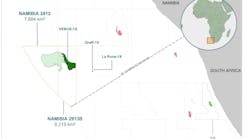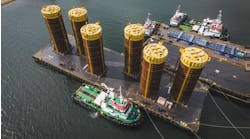David Paganie • Houston
Deepwater survey blitz continues
On the heels of Global Geo Services and TGS’ 50/50 JV multi-client survey in the deep waters of the eastern Gulf, CGGVeritas was scheduled to kicked off a central Gulf deepwater survey by the end of November, and TGS was expected launch additional survey work in the eastern GoM by the end of 2007.
CGGVeritas planned to begin its second multi-client wide-azimuth data acquisition program in the Gulf by the end of November. The survey was scheduled to cover Garden Banks, Keathley Canyon, and East Breaks areas.
CGG says this will be the largest wide-azimuth data library survey in the world, covering 600 OCS blocks. It would run concurrently with the Walker Ridge survey previously under way.
TheVanquish and Vision, each with 10 solid Sentinel streamers and two source vessels will produce a native 4,000-m (2.5-mi) crossline offset. Fast-Track Migration for the Garden Banks survey is scheduled to be available in December 2008.
TGS-NOPEC Geophysical Co. secured a $40-million pre-commitment contract for the company’s first wide-azimuth multi-client 3D survey. The initial program – mcWAZ Phase 1 – will cover approximately 650 OCS blocks (about 15,000 sq km [5,792 sq mi]) in the Mississippi Canyon and Atwater Valley areas.
Survey acquisition is expected to begin around year-end 2007, with data available in summer 2008. Final products will include both anisotropic Kirchhoff and anisotropic Wave Equation Pre-stack Depth Migration (PSDM).
Meanwhile, TGS says it is re-processing its existing Mississippi Canyon Revival 3D data using Turning Wave Kirchhoff PSDM with anisotropy correction for initial input into the mcWAZ processing sequence. Over 250 wells are being used for the anisotropic calibration, according to TGS.
The company believes that the mcWAZ program is the world’s largest contiguous WAZ program as well as the world’s largest 3D survey with anisotropic well calibration.
Meanwhile, Fugro GeoServices Inc.’s newbuild survey vesselFugro Enterprise has mobilized for the first of three deepwater surveys. The vessel carries a suite of high-resolution geophysical survey equipment including Echo Surveyor II, a Hugin 3000 AUV, as the primary system. The AUV is equipped with multibeam echosounder, side scan sonar, and sub-bottom profiler sensors capable of working for up to 60 hours continuously in water depths of 3,000 m (10,000 ft).
Survey data can be processed onboard and is available from the vessel in near real-time via broadband connection to Fugro’s and/or clients’ offices.
Rig contracts
Saipem has received a five-year, $860-million contract to charter the newbuild deepwater semisubmersible drilling rigScarabeo 9 to Eni. The rig is under construction at Yantai Raffles Shipyard, China, with delivery scheduled in 4Q 2009. The rig is capable of drilling in 3,600 m (11,811 ft) water depth in full DP mode.
Anadarko has awarded Transocean a $569-million contract for use of the drillshipDiscoverer Spirit for three years. The contract is expected to begin in December 2010, following the completion of the rig’s existing contract commitments in the region.
Callon Petroleum has awarded Diamond Offshore a $91-million contract for use of the semisubmersible rigOcean Victory to drill and complete two wells on the Entrada field in Garden Banks block 782. The wells will target sands between 13,000 and 21,000 ft (3,962-6,401 m) TVD. Entrada is being developed as a subsea tieback to the Magnolia TLP. First production is expected in 1Q 2009.
Diamond also entered into an LOI for a one-year commitment for theOcean America under which it could earn maximum total revenue of approximately $175 million.
MMS proposes date for central, eastern lease sales
The MMS proposes that lease sales 206 and 224 for the Central GoM and Eastern GoM planning areas be held consecutively on March 19, 2008.
Proposed Lease Sale 206 includes 5,000 unleased blocks covering more than 28.5 million acres in the central planning area offshore Louisiana, Mississippi, and Alabama. The acreage is 3 to 230 mi (5 to 370 km) offshore in water depths of 10 to 11,200 ft (3 to 3,400 m).
MMS estimates that this sale contains 0.877 to 1.457 Bbbl of oil and 3.653 to 5.892 tcf of natural gas.
Proposed Lease Sale 224 includes 118 whole or partial unleased blocks covering 547,230 acres in the eastern GoM planning area. The acreage is 125 mi (201 km) offshore, south of Florida and west of the Military Mission Line, in water depths from 2,657 to 10,213 ft (810 to 3,113 m).
“This is the first sale in the eastern planning area to offer these blocks since 1988,” says Stephen Allred, assistant secretary for Land and Minerals Management. “It is also the first sale where sharing provisions of the Energy Security Act will start immediately. The states of Alabama, Mississippi, Louisiana, and Texas will share in revenue from all leases resulting from this sale.”
MMS estimates that this sale contains from 100 to 140 MMbbl of oil and 0.16 to 0.34 tcf of natural gas. It will be the only sale in the eastern Gulf to be held during the current Five Year Program, according to the MMS.
Sales 206 and 224 include an increase in the royalty rate to 18.75% and will include rental rates of $6.25/acre for tracts in waters 200 m (656 ft) or less and $9.50/acre for tracts in deeper waters. The price threshold for deepwater royalty relief in Sale 206 is $35.75/bbl of oil and $4.47/Mcf of gas, both based on 2006 dollars.
More Chinook, Cascade contracts let
Petrobras America Inc. has contracted Heerema Marine Contractors to install infield flowlines at Chinook in the Walker Ridge area. The project includes two 12-mi (19-km) long pipe-in-pipe flowlines, each with a 14-in. (35.5-cm) casing pipe carrying a 9-in. (23-cm) inner pipe. Installation in 8,000-8,800 ft (2,440-2,680 m) water depth is scheduled for spring 2009.
Also, BW Offshore has awarded DPS (Bristol) Ltd. an EPC contract for the crude stabilization and flare modules for the Chinook and Cascade FPSO topsides. DPS will also manage the process and piping interfaces on the topsides.
In other deepwater news, Marathon has awarded Technip a contract for engineering and support services during the feasibility and definition stages of the Droshky oil field development. The field is in 2,900 ft (884 m) of water in Green Canyon block 244.
Technip’s work scope includes engineering and support for subsea trees, manifolds, two rigid flowlines, and an umbilical. The work will be carried out at Technip’s Houston office. Estimated completion is in 1Q 2008.
Meanwhile, Eni has started production from gas fields San Jacinto (DeSoto Canyon block 618), Spiderman (DC 620), and Q (Mississippi Canyon 961). All have been developed as subsea tiebacks to theIndependence Hub platform. Eni’s current daily net production from the three fields is approximately 26,000 boe.
ATP considering second MinDOC
ATP says it is evaluating the construction of a second MinDOC platform. It would be installed in Atwater Valley block 63 to recover an estimated 10-15 MMbbl of oil, the company says.
ATP has upgraded production capacity on its 100%-owned and operatedGomez production facility in Mississippi Canyon block 711. All five wells are connected and flowing at 20,000 b/d of oil. Associated gas accounts for an additional 60 MMcf/d.
The first MinDOC -Telemark Hub - is under construction. It will serve as the primary production facility for wells from Mississippi Canyon blocks 941/942 and Atwater Valley block 63. The well at AT 63 will be a subsea tieback to the hub. Platform sail-out is scheduled for summer 2008, with first production expected in 4Q 2008.
M-I Swaco opens Gulf Coast supply base
M-I Swaco has officially opened a new supply base in Cameron, Louisiana. It replaces the long-time facility destroyed in 2005 by Hurricane Rita.
The new supply base has been relocated to the Calcasieu Ship Channel in Cameron from the site it occupied since 1958. The new plant, which is now one of the largest facilities M-I Swaco operates on the Gulf Coast, has total mixing capacity for 4,000 bbl of water-base, synthetic-base, and oil-base drilling fluids and storage capacity for 39,000 bbl, including base fluids. The facility also has storage capacity for 55,000 sacks bulk barite, 4,000 sacks bulk gel, and 4,000 sacks of bulk lime.
“With 750 ft (229 m) of bulkhead and water depths capable of handling the largest deepwater vessels, this facility offers the latest in technology,” says Joe Bacho, M-I Swaco’s senior VP of the North American Business Unit. “The new Cameron facility is strategically positioned to service the needs of our customers in the expanding western GoM deepwater market.”
“Our new Cameron facility is second only to Port Fourchon as the largest and most technically advanced offshore supply and service base that M-I Swaco operates on the Gulf Coast,” says Larry Maddox, M-I Swaco’s southern US regional VP.
Chevron, MIT launch energy research initiative
Chevron and Massachusetts Institute of Technology (MIT) have launched a five-year global energy research program to develop remote, ultra deepwater exploration and production technology.
The $5-million program will focus on developing the technologies required to access hydrocarbons in water depths up to and greater than 3,000 m (9,842 ft).
“The need for affordable, sustainable energy is one of the greatest challenges of the 21st century,” says Ernest Moniz, director of the MIT Energy Initiative. “Conventional oil and gas supplies will play a critical role in meeting global energy demand for at least the next several decades, and advanced technologies are essential for producing these essential resources in environmentally sensitive ways.”
“Developing remote, ultra deepwater reserves is one of the greatest challenges the industry faces as we seek to meet the world’s growing demand for energy,” says Don Paul, VP and CTO of Chevron Corp.






